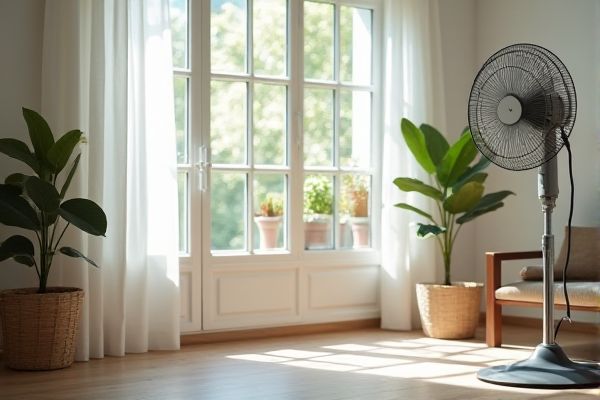
An air filtration unit removes airborne contaminants such as dust, pollen, and bacteria, improving indoor air quality, whereas a regular fan only circulates air without filtering it. Discover how choosing the right option can enhance Your environment by reading the rest of the article.
Table of Comparison
| Feature | Air Filtration Unit | Regular Fan |
|---|---|---|
| Primary Function | Removes airborne particles and pollutants | Circulates air without filtering |
| Air Quality Improvement | Significantly improves by filtering allergens, dust, and bacteria | No improvement; only air movement |
| Filtration Technology | HEPA, activated carbon, UV light options | None |
| Noise Level | Moderate to low depending on model | Low to moderate |
| Energy Consumption | Higher due to filtration mechanisms | Lower; typically less power required |
| Maintenance | Requires regular filter replacement or cleaning | Minimal maintenance; occasional dusting |
| Cost | Higher initial and upkeep cost | Lower upfront and maintenance cost |
| Best Use Case | Allergy sufferers, pollution-prone areas, improved indoor air quality | General air circulation, cooling effect |
Introduction to Air Filtration Units and Regular Fans
Air filtration units are designed to remove airborne particles, allergens, and pollutants, improving indoor air quality significantly more than regular fans. Regular fans primarily circulate air without filtering contaminants, which means they do not eliminate dust, smoke, or bacteria from your environment. Choosing an air filtration unit over a standard fan ensures cleaner, healthier air by actively trapping harmful particles rather than just moving air around.
How Air Filtration Units Work
Air filtration units use advanced filters such as HEPA or activated carbon to trap airborne particles, allergens, and pollutants, significantly improving indoor air quality compared to regular fans that simply circulate air without removing contaminants. These units force air through multiple filtration stages, capturing dust, pollen, smoke, and bacteria, which is essential for maintaining a healthier environment. Your choice of an air filtration unit ensures cleaner air by actively filtering out harmful particles rather than just redistributing them.
Understanding the Function of Regular Fans
Regular fans circulate air by creating airflow, which helps dissipate heat and improve ventilation in a room. Unlike air filtration units, fans do not remove pollutants, allergens, or airborne particles, making them less effective for improving indoor air quality. Your comfort relies on proper air circulation, but filtering contaminants requires specialized equipment beyond a standard fan.
Key Differences Between Air Filtration Units and Fans
Air filtration units actively remove airborne pollutants such as dust, allergens, and microorganisms using HEPA or activated carbon filters, improving indoor air quality, whereas regular fans only circulate air without eliminating contaminants. Air filtration units are equipped with specialized filters and purification technologies, delivering cleaner and healthier air, while fans primarily provide ventilation and cooling by moving existing air. The efficiency of air filtration units in capturing microscopic particles significantly surpasses that of fans, making them essential for allergy relief and pollution control.
Benefits of Using Air Filtration Units
Air filtration units significantly improve indoor air quality by removing pollutants, allergens, and airborne particles that regular fans cannot filter. They help reduce respiratory issues and create a healthier living environment, especially for asthma and allergy sufferers. Unlike standard fans that only circulate air, air filtration units actively clean the air, making them essential for homes and workplaces aiming to maintain optimal air purity.
Limitations of Regular Fans for Air Quality
Regular fans circulate air without removing pollutants, allergens, or airborne particles, limiting their effectiveness in improving indoor air quality. They simply move existing contaminants around rather than filtering them out, which can exacerbate issues for allergy or asthma sufferers. Your best option for cleaner air involves investing in an air filtration unit designed to capture and eliminate harmful particles.
Energy Consumption Comparison
Air filtration units generally consume more energy than regular fans due to the added power needed to operate filtration mechanisms like HEPA filters and ionizers. While standard fans primarily use electricity to circulate air, air purifiers require additional energy for fan motors designed to push air through dense filter materials, resulting in higher wattage usage. Energy-efficient models of air filtration units can reduce consumption, but on average, regular fans remain the more energy-saving option for basic airflow without air cleaning.
Maintenance and Longevity
Air filtration units require regular maintenance such as filter replacements every 3 to 6 months to ensure optimal air quality and system efficiency, while regular fans need minimal upkeep, mainly dusting and occasional lubrication. The longevity of air filtration units typically spans 5 to 10 years, depending on usage and filter quality, compared to fans, which can last 7 to 15 years with proper care. Choosing an air filtration unit helps maintain cleaner air but demands more consistent maintenance than a traditional fan to maximize durability.
Cost Effectiveness and Value
Air filtration units offer superior value by combining air purification with circulation, improving indoor air quality beyond what a regular fan provides. While initial costs for air filtration units are higher than standard fans, their ability to reduce allergens, dust, and airborne pollutants can lower health-related expenses and enhance overall well-being. Over time, the long-term benefits of cleaner air and reduced cleaning needs make air filtration units a more cost-effective investment compared to regular fans.
Choosing the Right Option for Your Space
An air filtration unit effectively removes airborne particles, allergens, and pollutants, improving indoor air quality far beyond the capabilities of a regular fan, which only circulates air without cleansing it. When choosing the right option for your space, consider factors such as room size, specific air quality needs, and potential health concerns like asthma or allergies. Your decision should prioritize air filtration units in environments requiring cleaner air, while fans may suffice for simple cooling and ventilation in well-ventilated areas.
 homyna.com
homyna.com